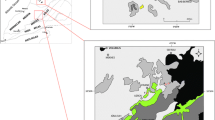Abstract
This article summarizes the material from geobotanical and biogeochemical studies into the vegetation of the Irkut River valley in the spurs of the Kitoi Goletzes of the Eastern Sayan Mountains. An analysis is made of the features in spatial structure and the floristic and phytocenotic diversity of vegetation of cryo-steppe open woodland, taiga larch forests and meadow-bog complexes in the high-mountain valley of the Irkut River. It was found that the landscapes of the subalpine cold forest–steppe represented by a combination of sparse herbaceous (ptylagrostis-cobresia, fescue) larch forests, shrub groups with the involvement of Spiraea alpina, Betula rotundifolia, and Dasiphora fruticosa, and communities of cryophytic steppes typically occur at altitudes of 2000 m above sea level. The latter constitute the original element of the forest–steppe, which is often dominated by the endemic fescue Festuca komaroviis. The dominant taiga vegetation is dominated by larch forests. Larch forests are dominant in the composition of prevailing taiga vegetation. These are mainly lingonberry–rhododendron–lichen larch forests and larch forests with lingonberry moss–lichen communities. The communities of subalpine larch forests of the Il’chir tract showed anomalies in the gold contents in samples of fruticose lichens, that is, reindeer lichen. The gold content in lichen samples varies from 0.1 to 0.8, and in some places it reaches 1–3 g/t. In general, in the Sayan alpine landscapes, gold–sulfide vein zones are known to occur in rocks of the Paleozoic volcanogenic–terrigenous formation and at its contact with the carbonate formation. Along the slope, gentle watershed ridges overgrown with taiga larch forests are interspersed with narrow hollows of cryogenic subsidence with the occurrence of boggy willow forests, sedge–cobresia, and ptyagrostis meadows with Dasiphora fruticosa. Only at the foothills, on bedrock terraces with outcrops of rocks of the Paleozoic carbonate formation, communities of the cobresia–fescue alpine steppe are formed.




Similar content being viewed by others
REFERENCES
Vernadskii, V.I., Khimicheskoe stroenie Zemli i ee okruzheniya (The Chemical Structure of the Earth and Its Surroundings), Moscow: Nauka, 1965.
Vinogradov, A.P., Biogeochemical provinces and their role in organic evolution, Geokhimiya, 1963, no. 3, pp. 199–212.
Malyshev, L.I., Speciation of plants in the mountains of Siberia, Sib. Ekol. Zh., 2002, no. 5, pp. 531–540.
Namzalov, B.B., Baikal phytogeographic node as the newest center of endemism of Inner Asia, Contemp. Probl. Ecol., 2009, vol. 2, no. 4, pp. 340–346.
Namzalov, B.B. and Taisaev, T.T., Endemism of biota of the Baikal Natural Area: origin, new nodes, and prospective studies, Vestn. Buryat. Nauchn. Tsentra, Sib. Otd., Ross. Akad. Nauk, 2015, no. 1 (17), pp. 164–174.
Imetkhenov, A.B., Physical map, in Atlas Respubliki Buryatiya (Atlas of the Buryatia Republic), Moscow: Fed. Sluzhba Geodez. Kartogr. Ross., 2000, pp. 8–9.
Polevaya geobotanika (Field Geobotany), Lavrenko, E.M. and Korchagin, A.A., Eds., Moscow: Nauka, 1964, vol. 3.
Flora Sibiri (Siberian Flora), Malyshev, L.I., Ed., Novosibirsk: Nauka, 1987–1997, vols. 1–14.
Ogureeva, G.N., The structure of high-altitude vegetation in Southern Siberia, Byull. Mosk. O-va. Ispyt. Prir., Otd. Biol., 1983, vol. 88, no. 1, pp. 66–77.
Telyatnikov, M.Yu., Rastitel’nost’ vostochnoi chasti Vostochnogo Sayana (vysokogornyi i gorno-lesnoi poyasa) (Vegetation of the Eastern Part of the Eastern Sayan (Alpine and Mountain–Forest Belts)), Novosibirsk: Akademizdat, 2016.
Krasheninnikov, I.M., Analysis of the relict flora of the Southern Urals related with the history of vegetation and Pleistocene paleogeography, Sov. Bot., 1937, no. 4, pp. 16–47.
Lavrenko, E.M., Pleistocene vegetation of periglacial steppes of the USSR, Bot. Zh., 1981, vol. 66, no. 3, pp. 313–327.
Alekseev, E.B., Festuca L.—fescue, in Flora Sibiri (Siberian Flora), Novosibirsk: Nauka, 1990, vol. 2, pp. 130–162.
Malyshev, L.I., Vegetation of the Eastern Sayan within the Buryat ASSR, Materialy Nauchnykh chtenii pamyati M.G. Popova (Proc. Scientific Readings in Memoriam of A.G. Popov), Irkutsk: Irkutsk. Knizhn. Izd., 1963, vol. 5, pp. 3–47.
Taisaev, T.T., Namzalov, B.B., and Oshorova, B.V., Landscape geochemistry and speciation in ecosystems of mountainous regions of the north of Central Asia, Materialy IX Ubsu-Nurskogo mezhdunarodnogo simpoziuma “Ekosistemy Tsentral’noi Azii: issledovaniya, problemy okhrany i prirodopol’zovaniya,” Kyzyl, 16–20 sentyabrya 2008 g. (Proc. IX Ubsunur Int. Symp. “Ecosystems of Central Asia: Research, Conservation, and Rational Utilization,” Kyzyl, September 16–20, 2008), Kyzyl: Tyvapoligraf, 2008, pp. 94–97.
Namzalov, B.B., Alymbaeva, Zh.B., and Kholboeva, S.A., Fescue of Baikal Siberia: ecological-geographic analysis and some aspects of phylogeny, Byull. Mosk. O-va. Ispyt. Prir., Otd. Biol., 2011, vol. 116, no. 5, pp. 47–54.
Mel’nikov, P.I., Ivanov, O.P., Makarov, V.N., Pitul’ko, V.M., and Shvartsev, S.L., The phenomenon of cryogenic migration of chemical elements and its role for discovery of new deposits in permafrost regions, Dokl. Akad. Nauk SSSR, 1988, vol. 303, no. 4, pp. 963–967.
Taisaev, T.T., Cryogenic systems of some gold-quartz deposits, Dokl. Akad. Nauk SSSR, 1991, vol. 317, no. 2, pp. 440–443.
Taisaev, T.T., The phenomenon of cryobiogenesis and self-organization of permafrost geochemical landscapes, Usp. Sovrem. Estestvozn., 2004, no. 1, pp. 20–24.
Taisaev, T.T., Landscape-geochemical factor of biodiversity and traditional nature management of mountain ecosystems, Sib. Ekol. Zh., 2002, no. 5, pp. 617–624.
Smagin, V.N., Il’inskaya, S.A., Nazimova, D.I., Novosel’tseva, I.F., and Cherednikova, Yu.S., Tipy lesov gor Yuzhnoi Sibiri (Forest Types of Mountains of Southern Siberia), Novosibirsk: Nauka, 1980.
Author information
Authors and Affiliations
Corresponding authors
Ethics declarations
The authors declare that they have no conflicts of interest.
Additional information
Translated by L. Solovyova
Rights and permissions
About this article
Cite this article
Namzalov, BT.B., Taisaev, T.T., Budazhapov, LZ.V. et al. The Vegetation of the Subalpine–Taiga Complex and Gold Accumulation by Larch Forests of Eastern Sayan. Geogr. Nat. Resour. 42, 361–369 (2021). https://doi.org/10.1134/S1875372821040119
Received:
Revised:
Accepted:
Published:
Issue Date:
DOI: https://doi.org/10.1134/S1875372821040119




